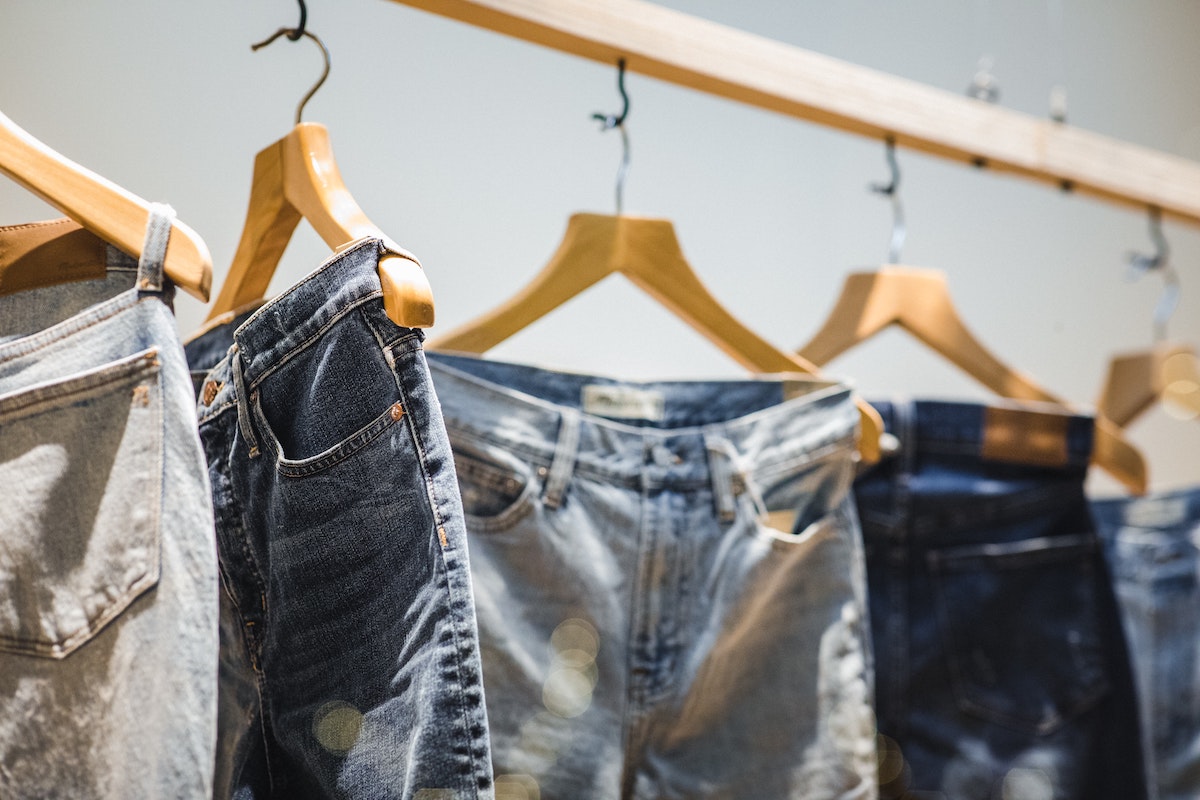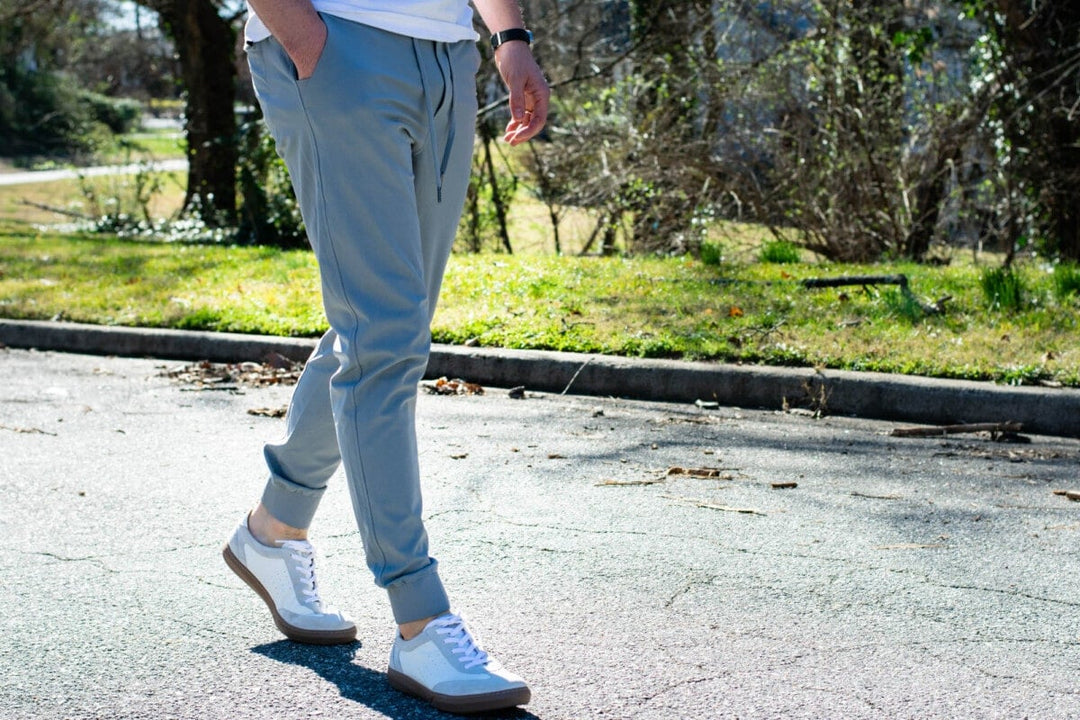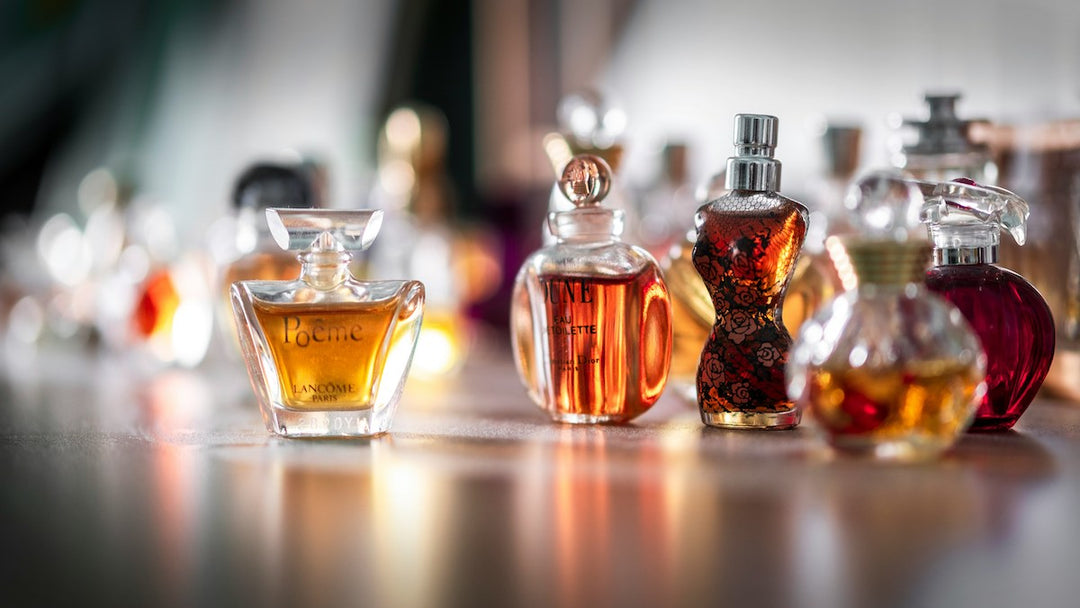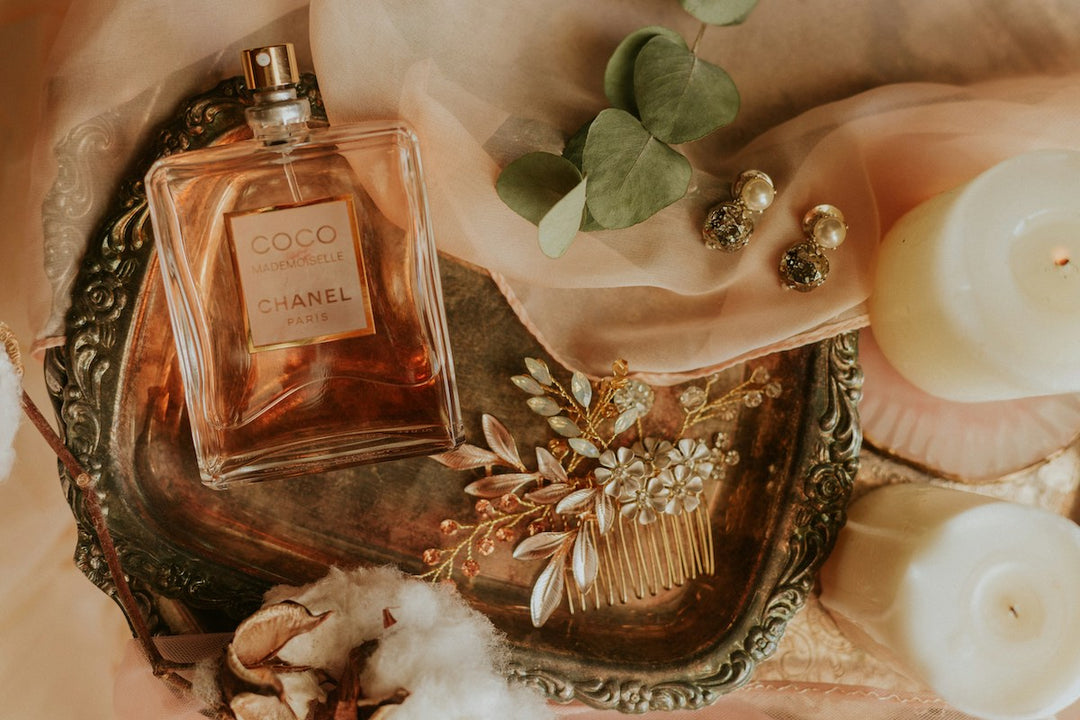Denim is a durable, twill-woven fabric typically made from cotton. It's the go-to material for jeans, jackets and other fashion items. The unique weaving process gives it that recognisable, rugged texture that we all love.
But it's not just about fashion. Denim's durability and versatility have made it a favourite in various industries.
From workwear to high fashion, denim's got you covered.
What is Denim?
What makes denim stand out in your wardrobe? If you're curious to know, let's get to the base of what defines this unique fabric.
Denim is a type of woven fabric that gets its strength from a distinctive process called twill weaving. In this method, the cotton threads are interlaced in a way that one thread usually goes under two or more threads diagonally, creating an identifiable pattern and a unique texture. The diagonal ribbing of denim, distinct to its twill weave, is what provides it with its recognisable rugged durability.
Knowing the anatomy of denim, it’s not surprising why it's has become such a staple in wardrobes around the globe.
How is Denim Made?
Making denim is an artistic process that starts with cotton. High-quality raw cotton is harvested and cleaned before it is spun into yarn. This cotton yarn then undergoes a dyeing process, traditionally with synthetic indigo dye, to give denim its characteristic blue colour. At this point, the blue cotton threads are interwoven with white threads in the twill method, producing the fabric with its signature blue and white colour scheme.
This synthetic indigo dye is a key component of denim, as it doesn't completely penetrate the cotton fibre. Instead, it clings to the surface of each cotton thread, which gives denim its unique quality of fading over time, a loved characteristic by denim enthusiasts.
Last but definitely not least, it's important to make a clear distinction between 'denim' and 'jeans'. Remember, denim is the fabric; jeans are one particular product made from this material. There are of course other items such as jackets, skirts and bags, but jeans are the archetype of denim use and a timeless staple in many wardrobes.
A Staple in Our Wardrobes
Denim, unarguably has become a significant part of our global fashion ecosystem. Its universality transcends cultures, borders, and age groups to emerge as a common thread in a myriad of wardrobes.
You'd agree, the versatility of denim is truly unparalleled. Whether it's a day at work, a casual outing, uphill hiking, or a trendy party, a piece of denim serves the occasion well. There's hardly a place you can't wear your favourite denim to and not feel chic, comfortable, or aptly dressed for the circumstance.
It's the dependability of this fabric that makes it a staple in our wardrobes. Sturdy, yet stylish, denim provides an effortless sense of comfort and trend. The durability and style it offers have made it a go-to option for many of us. But that's not all; it's the unique quality of fading over time gives each denim piece a personalised touch.
Let's look at the popularity of denim, more specifically jeans, from a statistical point of view. According to Statista, approximately 70% of the world's population wears jeans at least once a week. That's about 5.4 billion people donning a pair made from this versatile fabric.
|
Global Denim Jeans Worn Weekly |
Percentage |
Approximate Number of People |
|---|---|---|
|
Entire Population |
100% |
7.8 billion |
|
Population Wearing Jeans |
70% |
5.4 billion |
So as you can see, denim's appeal is not confined to any specific demographic. Both the young and the old, the modern and the conventional, all find it equally agreeable.
The Making of Denim
Stepping away from its popularity, let's get on with how denim is made. This robust, resilient fabric has a rich backstory. Manufacturing denim isn't as straightforward as you might think. So, let's explore the journey of cotton to jeans, revealing the craftsmanship behind your go-to fashion staple.
Primarily, cotton is a key ingredient in the making of denim. Numerous cotton strands spun together form a durable, soft yarn. This process might differ between manufacturers, but essentially, it's all about combining multiple strands for strength and longevity.
Post spinning, it's time for dyeing the cotton yarn. Indigo, the dye used to give jeans their iconic blue colour, is applied to the yarn. But here's the interesting part! Only the surface of the yarn is coated with indigo, keeping the white core intact - a unique process responsible for the faded effect of denim over time.
Once dyeing is done, weaving comes into play. It’s the crossover of horizontal and vertical yarns, but only the latter is dyed giving jeans their unique white-inside-blue-outside look. After weaving, the raw denim is treated with starch to minimise shrinkage and twisting. This process is known as sizing.
Lastly, the sized denim undergoes a series of treatments depending on the style and finish desired. Sandblasting, acid washing, or stone washing are a few ways to add character and add the much-loved distressed look to your jeans.
The Unique Texture of Denim
As you venture into the world of denim, your appreciation for this seemingly straightforward fabric is bound to deepen. One fascinating aspect resides in its incredible texture. Denim's unique texture not only provides character and distinction but also contributes significantly to its durability and comfort.
Ever observed that characteristic "diagonal ribbing" on one side of denim? It's down to the twill weaving technique used in its production. This technique involves passing the weft (crosswise yarn) under two or more warp threads (lengthwise yarn), resulting in a pattern of parallel diagonal lines.
This distinctive texture of denim is not just for aesthetics. It enhances the fabric's strength and durability, enabling it to withstand more wear and tear compared to other fabrics. Your favourite pair of jeans was likely able to survive countless washings and rough usage primarily because of this unique weaving structure.
Denim is also highly absorbent, thanks to this texture, making it an excellent material for dyed fabrics. It retains the deep, rich hues of indigo dye - the classic colour of your favourite jeans - exceptionally well. But it doesn't stop there. This absorbency also means that over time, the way you wear and wash your jeans will cause the dye to fade uniquely, giving your jeans a personal touch.
And it's not all about toughness and durability; denim delivers on comfort too. The twill weaving technique gives denim its slight stretch, ensuring your jeans maintain a perfect fit while not compromising on comfort.
Exploring the manufacturing process of denim reveals the complexity behind each pair of jeans that ensures durability, retains dye, and offers comfort. A seemingly simple attire, denim continues to play a crucial role in fashion across the globe. Now that you're aware of the texture nuance, you'll probably never look at your jeans in the same way again.
Denim's Versatility in Fashion and Beyond
When you consider the vast array of outfits and styles that can be created with denim, it's no wonder it's a vital player in the fashion world. Denim's versatility is genuinely unmatched – transcending seasons, trends, and personal style aesthetics. Whether it's a pair of classic indigo jeans, a chic denim jacket, or an edgy denim skirt, the possibilities of incorporating denim into your fashion repertoire are vast.
While denim's toughness and durability originally suited it for labour-intensive work, it's the spectacular adaptability of this fabric that's seen it become a star in the fashion world. From catwalks to streetwear, from high-fashion brands to affordable retail stores – everywhere you look, denim is there. It's using its enduring charm to cater to a diverse range of customers with varying tastes and styles. It appeals to an extensive demographic, from youngsters relishing their first pair of jeans to adults seeking a reliable, everyday staple.
The denim trend isn't only restricted to clothing. It's become a choice of substance in interior decor, accessories, and even art. From denim upholstered furniture to denim shoes and bags – this iconic fabric has expanded its reach far beyond fashion.
Furthermore, denim’s proven environmental benefits also contribute to its versatility. With many brands now focusing on sustainable fashion, denim is appearing at the forefront of eco-responsibility. Its inherent durability means fewer replacements, leading to less waste of resources and thus making it an eco-friendly choice. It's also being recycled into insulation materials for homes, thus showing its adaptable nature beyond fashion.
Hence, You see, denim's versatility goes far beyond the domain of fashion. Its sturdy construction, captivating appearance, lasting comfort, and unexpected eco-friendliness all unite to assure that denim maintains its global status as a reliable favourite.
Frequently Asked Questions
Why is denim popular in the fashion world?
Denim is popular in fashion due to its versatility. It can be incorporated into various outfits and styles, making it an essential element in different fashion statements.
How has denim extended its appeal beyond clothing?
In addition to being a staple in many wardrobes, denim has been utilised in interior decor, accessories, and even art. This has broadened its appeal beyond just clothing.
What are the environmental benefits of denim?
Many clothing companies are now focusing on the sustainable production of denim. Denim's durability adds to its eco-friendliness as it tends to last longer, reducing the necessity for fast fashion purchases.
How does denim contribute to sustainable fashion?
The durability of denim contributes to its sustainability; items made from denim often have a longer lifespan compared to other clothing materials. Nowadays, many brands are focusing on environmentally friendly ways to produce denim, further enhancing its sustainability.
Why is denim referred to as versatile?
Denim's versatility lies in its adaptability to different styles, its durability, and the growing focus on its sustainable production. Its contribution to various sectors beyond fashion, like interior design, also adds to this versatility.
Summary of Denim
So, you've seen the many facets of denim. Its versatility and durability make it a staple in your wardrobe and beyond.
Whether you're dressing up or down, denim's got your back. It's not just about fashion, it's about sustainability too. Brands are recognising this, creating eco-friendly options that let you stay stylish while caring for the planet.
From clothing to home decor, denim's influence is far-reaching. Its appeal is undeniable, making it a timeless choice in the ever-changing world of fashion.






Leave a comment